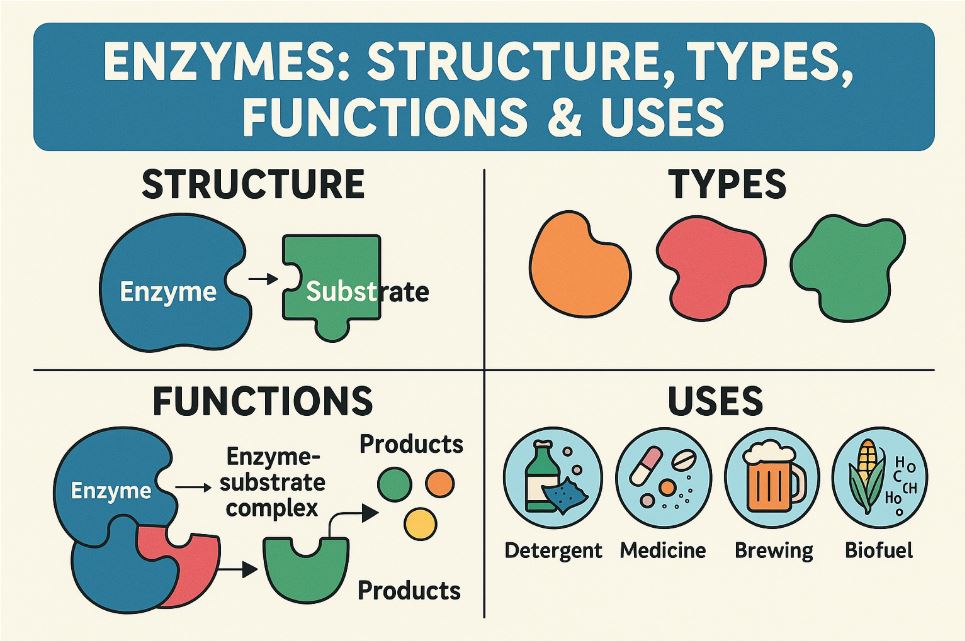Enzymes: Structure, Types, Functions & Uses :

Table of Contents
- Introduction to Enzymes
- What Are Enzymes Made Of?
- How Do Enzymes Work?
- Types of Enzymes by Function
- Types of Enzymes by Substrate
- Factors Affecting Enzyme Activity
- Enzyme Inhibitors and Activators
- Enzymes in Daily Life and Industry
- Comparison Table of Enzyme Types
- Chart: Enzyme Action Explained
- FAQs About Enzymes
- Conclusion
1. Introduction to Enzymes
Enzymes are biological catalysts that speed up chemical reactions in living organisms. From digestion to DNA replication, enzymes are essential for life. Without them, these processes would take place too slowly to sustain life.
💡 Fun Fact: Every cell in your body contains thousands of different enzymes!
2. What Are Enzymes Made Of?
Enzymes are proteins made from long chains of amino acids. These chains are folded into a unique 3D shape. The active site of an enzyme is the region where the chemical reaction occurs.
Enzyme Structure Breakdown
| Component | Description |
|---|---|
| Amino Acids | Building blocks of enzymes |
| Active Site | Area where substrate binds |
| Substrate | Molecule the enzyme acts on |
| Enzyme-Substrate Complex | Temporary binding of enzyme & substrate |
| Cofactors/Coenzymes | Non-protein helpers (e.g., vitamins, metals) |
3. How Do Enzymes Work?
Enzymes speed up reactions by lowering the activation energy required.
Two Main Models:
- Lock and Key Model: Substrate fits perfectly into the active site.
- Induced Fit Model: Enzyme changes shape slightly to fit the substrate.
📈 Result: Reactions happen millions of times faster with enzymes.
4. Types of Enzymes by Function (with Examples)
Here are the 6 major classes of enzymes classified based on the type of reaction they catalyze:
| Enzyme Class | Function | Example |
|---|---|---|
| Oxidoreductases | Oxidation-reduction reactions | Alcohol dehydrogenase |
| Transferases | Transfer of functional groups | Kinase, Aminotransferase |
| Hydrolases | Break molecules using water (hydrolysis) | Amylase, Protease |
| Lyases | Add/remove atoms to/from double bonds | Decarboxylase |
| Isomerases | Rearrange atoms within molecules | Glucose isomerase |
| Ligases | Join molecules using ATP | DNA ligase |
5. Types of Enzymes by Substrate (Common Enzymes)
These enzymes are categorized based on what they act upon:
| Enzyme | Substrate | Function | Where It’s Found |
|---|---|---|---|
| Amylase | Starch | Breaks starch into sugars | Saliva, pancreas |
| Protease | Protein | Breaks proteins into amino acids | Stomach, small intestine |
| Lipase | Fat (lipids) | Breaks fats into fatty acids | Pancreas |
| Lactase | Lactose (milk sugar) | Breaks lactose into glucose & galactose | Small intestine |
| Cellulase | Cellulose | Breaks plant fibers | Bacteria, fungi |
6. Factors Affecting Enzyme Activity
| Factor | Effect on Enzymes |
|---|---|
| Temperature | Too high can denature (destroy) enzyme shape |
| pH Level | Each enzyme works best at a specific pH |
| Substrate Concentration | More substrate = faster reaction (until saturated) |
| Inhibitors | Block enzyme activity (used in medicine) |
| Cofactors | Help enzyme work (e.g., metal ions, vitamins) |
7. Enzyme Inhibitors and Activators
🔴 Inhibitors:
- Competitive: Compete with substrate for the active site.
- Non-competitive: Attach elsewhere and change enzyme shape.
🟢 Activators:
- Help enzymes work better or faster.
- Often needed in small amounts (e.g., calcium, magnesium).
8. Enzymes in Daily Life and Industry
| Application Area | Use of Enzymes | Example Enzyme |
|---|---|---|
| Food Industry | Cheese, beer, bread, juice clarification | Rennet, amylase |
| Medicine | Disease diagnosis and drug manufacturing | DNA polymerase |
| Cleaning Products | Detergents to break stains | Protease, lipase |
| Agriculture | Improve soil nutrients and decomposition | Urease, cellulase |
| Biofuels | Break down plant material for fuel | Cellulase |
9. Comparison Table of Major Enzyme Types
| Class | Structure Feature | Example Reaction | Importance |
|---|---|---|---|
| Hydrolases | Water involvement | Break starch | Digestion |
| Oxidoreductases | Electron transfer | Alcohol → Acetaldehyde | Respiration |
| Transferases | Group transfer | Add phosphate group | Signal transduction |
| Lyases | Bond breaking without water | Remove CO₂ | Metabolism |
| Isomerases | Rearrangement | Glucose ↔ Fructose | Sugar metabolism |
| Ligases | Bond formation (needs ATP) | DNA strand joining | Genetic repair |
10. Chart: How Enzymes Work
plaintextTemperature ↑ → Activity ↑ (until optimum), then ↓
pH too low/high → Activity ↓
More substrate → Faster reaction (until saturation)
Enzyme + Substrate → Enzyme-Substrate Complex → Products + Enzyme11. FAQs About Enzymes
Q1: Are enzymes living things?
No. Enzymes are proteins, not living organisms.Q2: Can enzymes be reused?
Yes. Enzymes are not consumed in the reactions they catalyze.Q3: What happens if enzymes are missing or not working properly?
This can lead to diseases like lactose intolerance, Tay-Sachs, or digestive issues.Q4: Are all enzymes proteins?
Most are. Some RNA molecules (ribozymes) also act as enzymes.Q5: Can enzymes work outside the human body?
Yes. Many enzymes are used in industries like food, cleaning, and biofuels.
12. Conclusion
Enzymes are one of the most vital components of life. They carry out essential functions in the body, speed up reactions, and have countless applications in industry and medicine. Understanding how enzymes work can help us improve health, efficiency, and sustainability.
🎯 Whether you're a student, teacher, researcher, or curious reader — this guide is your one-stop source for everything about enzymes!